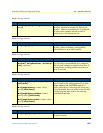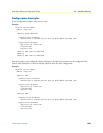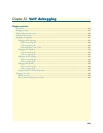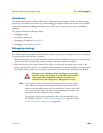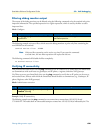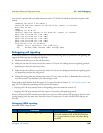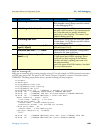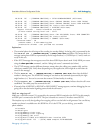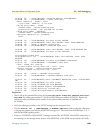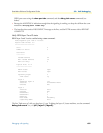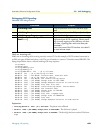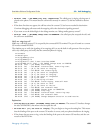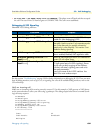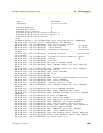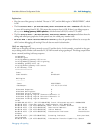
Debugging call signaling 629
SmartWare Software Configuration Guide 52 • VoIP debugging
18:34:10 ICC > [TERMINAL-00b73348] >> SETUP ACKNOWLEDGEMENT (DSS1 Ntwk)
18:34:10 ICC > [TERMINAL-00b73348] State: OVERLAP SENDING, Event: PEER TRYING
18:34:10 ICC > [TERMINAL-00b73348] State: OVERLAP SENDING, Event: PEER ALERTING
18:34:10 ICC > [TERMINAL-00b73348] Set state to CALL DELIVERED
18:34:10 ICC > [TERMINAL-00b73348] >> ALERTING (DSS1 Ntwk)
Progress indicator : inband information available
private network serving local user - CCITT
18:34:18 ICC > [TERMINAL-00b73348] State: CALL DELIVERED, Event: PEER CONNECTED
18:34:18 ICC > [TERMINAL-00b73348] Set state to ACTIVE
18:34:18 ICC > [TERMINAL-00b73348] >> CONNECT (DSS1 Ntwk)
Connected number : 50
unknown number - E.164 numbering plan
presentation allowed - user provided not screened
Explanation:
• The terminal places the call using en-bloc sending (no overlap dialing). In the log, this is represented by the
lines
18:34:10 ICC > [TERMINAL-00b73348] << SETUP (DSS1 Ntwk) and below. This means there is a
message coming from ISDN as represented by the left angle brackets (<<). ISDN layer1, 2 and 3 work cor-
rectly in this case.
• If the SETUP message does not appear, one of the lower ISDN layers doesn’t work. Verify ISDN port status
using the
show port isdn command , and the “debug isdn events” commands (see below).
• The SETUP message contains different elements, among others the calling party number (60), and the
called party number (50). Verify these (depending on your application, there might be as well other ele-
ments in the message).
• The line
18:34:10 ICC > [TERMINAL-00b73348] >> ALERTING (DSS1 Ntwk) shows that the dialed
number is alerting now. The ALERTING message is sent back to the terminals represented by the right
angle brackets (>>). You can be sure now that context CS functionality is working.
• The line
18:34:18 ICC > [TERMINAL-00b73348] >> CONNECT (DSS1 Ntwk) indicates that the call is now
established. The called party has answered the call.
• If instead of the ALERTING, a RELEASE or DISCONNECT message appears, continue debugging the out-
going call on the destination signaling protocol and the call-router.
Verify an outgoing call
Make sure a call from context CS is accepted by the connected ISDN terminal or the PSTN. In this example,
an ISDN port is connected to the PSTN. The port is bound to a context CS interface named PSTN.
The simplest way to verify the signaling of an outgoing call is to use the built-in call generator. You can dial any
number you know is reachable over this ISDN line. If it is the PSTN, you can dial e.g. your mobile
phone number.
unit>enable
unit#configure
unit(cfg)#debug ccisdn error
unit(cfg)#debug ccisdn signaling
unit(cfg)#debug isdn error
unit(cfg)#call 123456 dial 987654321 dest-interface PSTN
unit(cfg)#22:03:06 ICC > [PSTN] Added endpoint PSTN-00b70a20



